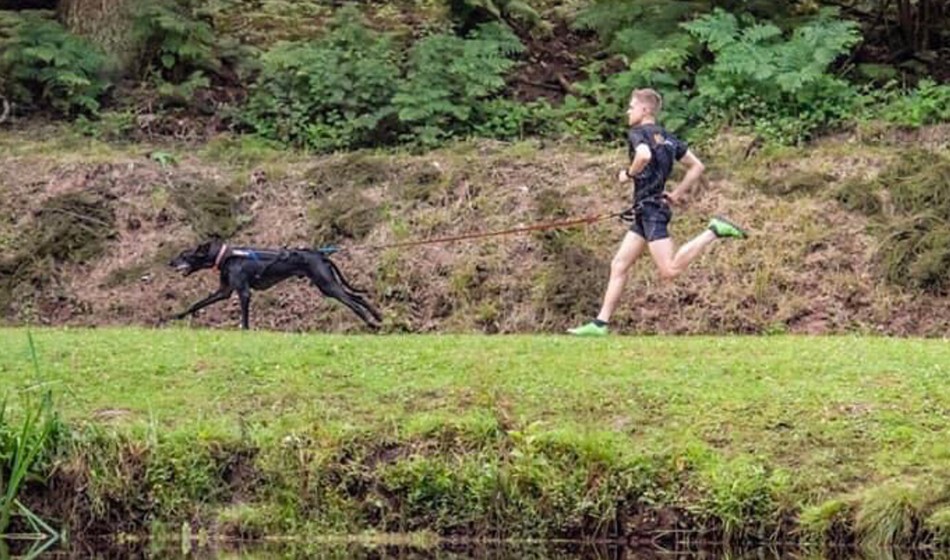
Waist harnesses and bungee-style leads to be banned at 5km events to reduce accidents but spare a thought for the health of the animals
The Lanhydrock estate in the West Country of England hosts one of the toughest parkruns around. Hillier and more rugged underfoot than your average cross-country course, it is not known for its fast times and the first runner home this weekend was David Tregonning with 17:42.
Tregonning is a fine runner in his own right but on this occasion was helped by a beautiful black Labrador that was tied to his waist with a harness and belt. During one of two small woodland loops in the middle of the event, this man-dog combo lapped me as I plodded along minus any canine assistance. Ultimately I finished well down the field but even the runner-up, Robert Orton, was almost three minutes adrift.
For Tregonning it will be the last time he is able to take part in a parkrun with his dog attached to his waist via a belt and a bungee-style lead. Parkrun organisers are bringing in a new rule from next Saturday (April 2) which bans such equipment and instead allows dogs to take part only if they are on “a short, handheld, non-extendable lead by the side of the participant, and within reach at all times”.
The decision has led to huge debate and considerable coverage, with most national newspapers reporting on the story and focusing on one junior parkrun organiser who has quit in disgust to form his own breakaway ‘barkrun’ group.
David Tregonning and his dog shortly after the Lanhydrock parkrun
Some runners claim the new rules make them feel excluded and one columnist from the Telegraph got particularly carried away when he wrote: “Sadly, like any event which routinely brings together groups of the British middle classes, as it has matured parkrun has evolved into something much more sinister.
“Seventeen years since its foundation,” he added, “parkrun is a seething pit of anxiety about status, wealth, fitness and the fitness of your children.”
Rachel Burden, incidentally, the long-time BBC5 Live presenter, dismissed the Telegraph article as “b******s”.
Explaining why they have introduced the new rules, parkrun say more than 10% of ‘incidents’ at parkrun events involve dogs and they add: “When participants use waist harnesses, there is an increased risk of serious incidents, particularly trips and falls, compared to when using handheld leads.”
READ MORE: Full parkrun statement on running with dogs
“Unfortunately, the nature of parkrunning with a waist harness is such that the lead allows dogs to move from side to side, in front of the participant, which can result in the dog suddenly and unexpectedly crossing in front of other participants on the course.”
In 2020 I interviewed world and European CaniCross champion Ben Robinson. As a decent club runner he can clock 14:36 for 5km but when he teams up with dog he has managed an incredible 12:09. It’s almost half a minute faster than Joshua Cheptegei’s track world record of 12:35.36 and, what’s more, Robinson races with his dogs on undulating and grassy trails which are kind to his pet’s feet.
Robinson began competing in CaniCross – the sport of running with a dog – with a Weimaraner called Bolt. But despite having the same name as the Jamaican Olympic sprints legend, he had limited success and more recently has raced with a German pointer, greyhound and Alaskan husky mixed breed called Blake that is specifically bred for strength, speed and stamina.
CaniCross specialist Ben Robinson
As a lifelong runner who has owned a number of dogs during my life, I do not have a particularly strong opinion on the rules of running with dogs in parkrun events. But I would agree with Robinson’s views on the type of equipment that should be used.
“A harness is important for a safety point of view,” he told me. “A standard lead and collar mean the dog will be pulling on its neck. You also won’t get as much of the power.
“Health-wise they will be pulling from the right point as well so they’ll be unlikely to get as many issues and you will feel a big difference in the pull you’ll get from the dog.”
During the debate so far, much has been said about runners potentially tripping up, or feeling excluded due to the new rules, or dare I say being ‘beaten’ to the finish line by a runner pulled along by a dog. But spare a thought for the animal itself.
READ MORE: Fastest and slowest parkrun courses
The new parkrun rules prevent runners from wearing a belt, but dogs can – and should – still wear a harness instead of a traditional collar so that the animal does not hurt its neck or throat.
Alternatively, if you do not want to stop running with your dog tied to your waist with a stretchable lead, then you could always join the growing world of CaniCross instead.















 Phone: (800) 737. 6040
Phone: (800) 737. 6040 Fax: (800) 825 5558
Fax: (800) 825 5558 Website:
Website:  Email:
Email: 






